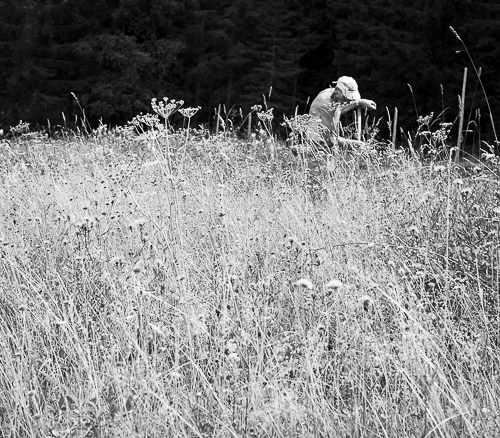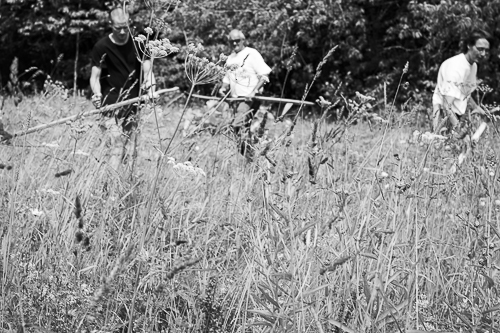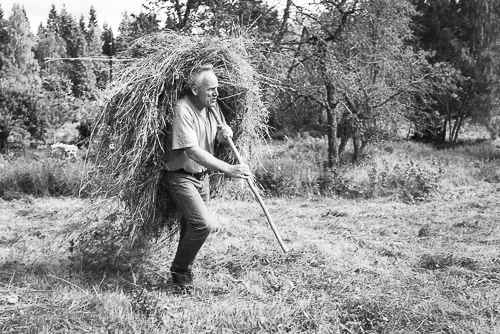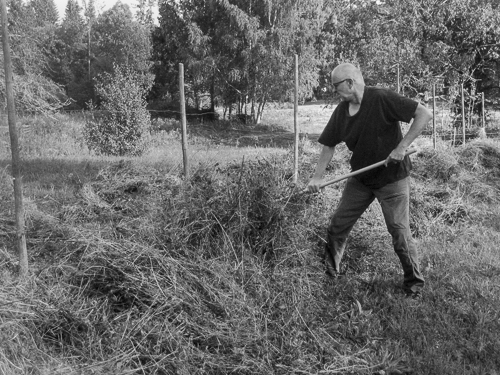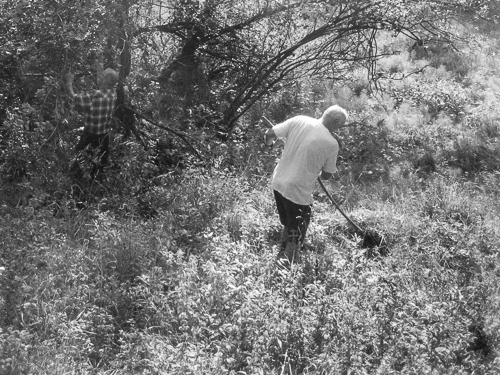For the last 3 years, I have been helping with haymaking at Flåret near Sjåstad in the commune of Lier. During the haymaking course at Ryghsetra, I met the chairman of the Friends of the Earth in Lier and the son of the present owner of Flåret. Since they intended to do haymaking at Flåret one week after the haymaking course, I naturally joined them. The local Friends of the Earth association had also got a botanic survey (in Norwegian) of the meadows where 76 different types of plants were found and about 40 of them were characterised as typical for meadows.
As far as I know, Flåret was a small farm which became part of the big farm called Sjåstad, relatively speaking, in 1801. Thereafter, the land was cultivated, animals were raised and various kinds of vegetables and fruits were cultivated until the 1950s when marginal farmland was abandoned. For the next 60 years, the place was inhabited, but not maintained. However, from 2014 onwards, the most biologically diverse meadows at Flåret have been cut with scythes, while the ones with less diversity have been cut with a machine, and the hay has been put on hay racks for drying.
When the hay has dried, we return and pull the hay from the hay racks to the ground. Next, we gather it in rows by means of rakes. Then, a tractor pulls a machine which turns the hay into hay bales. Finally, we carry the hay bales up to a road passing through the property. After we have left, the hay bales will be brought to a barn where they will be stored and sold to farmers with domestic animals, which love eating this diverse type of fodder.
The first two years, we harvested hay on the second week of July, that is one week after the haymaking course at Ryghsetra, but this year it was deferred to the second weekend of August in order to ensure that the plants on the meadows had produced seeds.
The first year we started, the meadows were completely overgrown and garden flowers like lupinus were abundant. This year, they were all gone and lots of trees had been cut down such that more sunlight could enter. By continuing this work, we should be able to create a biologically diverse “island” in a forest where commercial forestry prevents it from occurring. In fact, there have been many meadows in the forest above the valley of Lier where people have raised animals and used the hay on the meadows to feed them in winter. However, since the 1950s, these places have, in general, not been maintained such that they will gradually disappear if nothing is done.
This year, 2018, we only put hay on hay racks, while the owner used a machine to cut the hay. A recording of the manual work can be listened to here. For the first time, I have pulled hay down from the hay racks and this work was surprisingly tiring. First, we had to grab a large piece of hay and throw it to the side of the hay rack, next we had to to do the same again along the whole length of the hay rack and we had to do the same on the other side. Next, we used rakes to get any hay, which had been left behind and we had to shape the two rows of hay more less regularly such that the hay bales would be regular. We also needed to pull the hay apart since it seemed like the individual parts were attached to each other.
The week before we were haymaking at Flåret, I was doing haymaking at another former homestead, called Myresetra. It was abandoned more than 100 years ago, but animals had been grazing there until the 1970s. More than 40 years with no grazing had led to that the meadows were being overgrown and trees had started turning the meadows into forest. Fortunately, the commune of Drammen recently bought the meadows and the surrounding area. In addition, locals are welcome to join haymaking on the meadows in August. On a rainy day, a small group of volunteers filled two hay racks with hay and used scythes to cut even more. Since the hay racks were full, we spread the excess hay evenly on the ground in order to let it dry.
After we had finished haymaking, the leader of the local history club told us about the last family who had been living there. A Swedish man, who had just arrived in Norway, was told that he could stay there. He and his wife brought up their children in this somewhat remote place and the children had to walk to school and back again daily. The family had some cows and they also cared for other people’s cows for payment. Since a brook is passing the meadows, the Swede set up a water-powered lathe on which he made various wooden products, which he could sell. Afterwards, he moved to the U.S. where he stayed for the rest of his life.
This year, 2018, I went back to Myresetra to cut hay again, but first we had to listen to another history lesson. We were told that this meadow had been in use at least since 1704 because there is a document from a trial regarding this place from that year. It was inhabited until the 1920s and livestock were grazing here until the 1970s. During all the time it was inhabited, it was common to let cattle stay on the meadow for a small charge.
Next, we cut hay and put it under trees because no farmers wanted to collect it. In order to keep the meadow open, it’s necessary to cut it every year and remove the cuttings, else they will fertilise the meadow.
